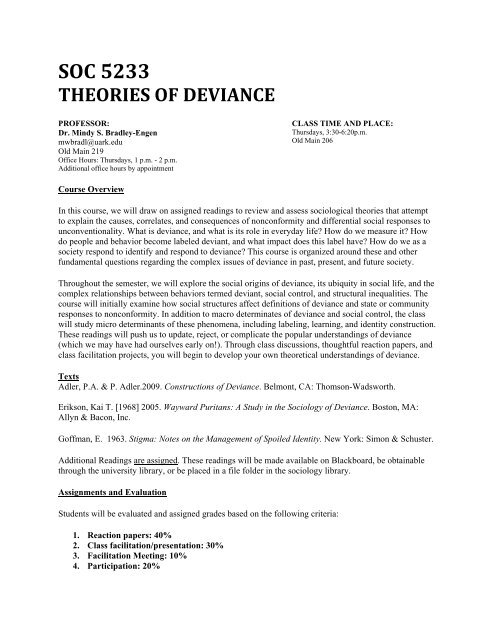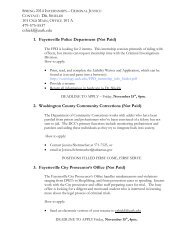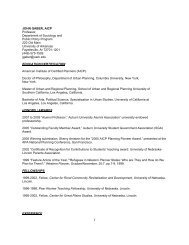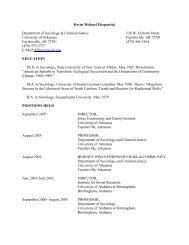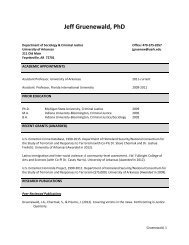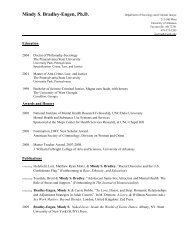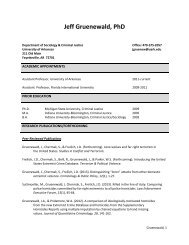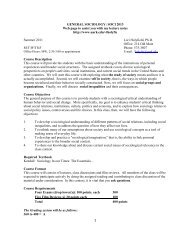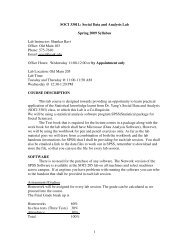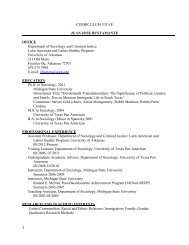THEORIES OF DEVIANCE
THEORIES OF DEVIANCE
THEORIES OF DEVIANCE
You also want an ePaper? Increase the reach of your titles
YUMPU automatically turns print PDFs into web optimized ePapers that Google loves.
SOC 5233<strong>THEORIES</strong> <strong>OF</strong> <strong>DEVIANCE</strong>PR<strong>OF</strong>ESSOR:Dr. Mindy S. Bradley-Engenmwbradl@uark.eduOld Main 219Office Hours: Thursdays, 1 p.m. - 2 p.m.Additional office hours by appointmentCLASS TIME AND PLACE:Thursdays, 3:30-6:20p.m.Old Main 206Course OverviewIn this course, we will draw on assigned readings to review and assess sociological theories that attemptto explain the causes, correlates, and consequences of nonconformity and differential social responses tounconventionality. What is deviance, and what is its role in everyday life? How do we measure it? Howdo people and behavior become labeled deviant, and what impact does this label have? How do we as asociety respond to identify and respond to deviance? This course is organized around these and otherfundamental questions regarding the complex issues of deviance in past, present, and future society.Throughout the semester, we will explore the social origins of deviance, its ubiquity in social life, and thecomplex relationships between behaviors termed deviant, social control, and structural inequalities. Thecourse will initially examine how social structures affect definitions of deviance and state or communityresponses to nonconformity. In addition to macro determinates of deviance and social control, the classwill study micro determinants of these phenomena, including labeling, learning, and identity construction.These readings will push us to update, reject, or complicate the popular understandings of deviance(which we may have had ourselves early on!). Through class discussions, thoughtful reaction papers, andclass facilitation projects, you will begin to develop your own theoretical understandings of deviance.TextsAdler, P.A. & P. Adler.2009. Constructions of Deviance. Belmont, CA: Thomson-Wadsworth.Erikson, Kai T. [1968] 2005. Wayward Puritans: A Study in the Sociology of Deviance. Boston, MA:Allyn & Bacon, Inc.Goffman, E. 1963. Stigma: Notes on the Management of Spoiled Identity. New York: Simon & Schuster.Additional Readings are assigned. These readings will be made available on Blackboard, be obtainablethrough the university library, or be placed in a file folder in the sociology library.Assignments and EvaluationStudents will be evaluated and assigned grades based on the following criteria:1. Reaction papers: 40%2. Class facilitation/presentation: 30%3. Facilitation Meeting: 10%4. Participation: 20%
1. Reaction Paper/Response to the readingsYou will be required to write one short reaction paper for each week of the course when reading isassigned. Each student will email his/her paper both as a Word document attachment and in the text of theemail to all of the other students in the class. All students and I must receive these reaction essays before8a.m. on the Wednesday prior to class .These are due no later than 8 a.m. the Wednesday before wediscuss the readings in class Thursday afternoon. However, turning the papers in earlier is recommendeditwill give you ample time to read other students’ responses and be prepared to discuss them in classwhichwill increase you participation grade!In these one to three page response papers (single-spaced, in Times New Roman 12 pt. font, min 300words), you will analyze and evaluate authors’ claims to demonstrate a thorough reading and criticalunderstanding of the material. Your summary should be no longer than one paragraph (if there’s only onereading) or few small paragraphs (if there is more than one reading). Your response should stay groundedin the text; you must support all of your claims.Reaction paper structure:First paragraph (s): SummaryStart your response with a sentence that states what the readings have in common. Next,demonstrate that you understand the main points – both substantive and theoretical – of eacharticle. To do this, write one to two sentences for each article stating the thesis of that article.Finally, end this first paragraph with a sentence that tells me what you are going to argue in thisresponse. This integration, summary, and statement of argument should take no more than oneparagraph per reading.Remaining paragraphs: BodyThe body of the response should be an exposition of your argument that stays grounded in thetext. Remember to include a conclusion paragraph that restates your argument. Draw linksbetween the questions an author poses and the theoretical framework that is developed. Youshould commit to handing in a well-written, well-organized response! These reaction papers willcount for 40% of your overall grade!!Ask yourself: What is the point of the article? To which larger question (s) regarding deviance does itspeak? How does it fit in with larger ideas/concepts in sociology? What questions does it raise, bothspecifically, and more generally to the study of deviance?Scoring:You must right reaction papers for 10 out of the 12 weeks that reaction papers are assigned class. Eachreaction paper will count as 4% of your overall grade, for a total of 40%. This gives you the opportunityto skip up to 2 reaction paper assignments without penalty. So, you must write a reaction paper for 10weeks out of the semester in order to receive an A for the reaction paper assignment grade.2. Class leadership/facilitationEach weekly meeting will be lead by a student facilitation team. Each seminar participant is required to bea member of the leadership team for at least two different weeks. For each of these weeks, the studentsare responsible for providing a 20-30 minute summary, discussion, and thoughtful analysis of the week’sreadings. Following their presentation, they will pose major talking points and questions for class
discussion. The weeks for which you will be responsible will be determined on the first day of class. Foreach of the two weeks you choose, your team must prepare a 20-30 minute presentation/discussion,outlining the key themes of the reading and the issues you think are worthy of discussion. Each memberof the team must also be prepared to discuss the class reaction papers submitted for that week, and engagediscussion from other members of the seminar. The team should read all of the reaction papers, andidentify some key themes, ideas, or issues raised by their fellow students. The student leaders are free todevelop relevant and appropriate class exercises or other projects during class time as well, to encourageparticipation and convey the material. Each class facilitation week will count for 15% of your overallgrade (for a total of 30%).3. Facilitation MeetingDuring the week you are facilitating, you will meet with me during my office hours (Thursdays, 1-2 pm)to go over your presentation material and discuss your plans/agenda for the class. These meetings willcount for 10% of your overall grade-each meeting will be 5% of your grade. EVERY member of the teammust be present at the facilitation meeting. ONLY class conflicts will be justification for not attending themeeting. In the event that a team member has class during this time, s/he must schedule a separatemeeting with me at another suitable time.4. ParticipationBecause our learning is based on thorough critical scholarly analysis of the readings, and will progressthrough discussions, conversations, and reflections, full attendance and participation is critical to thesuccessful functioning of this class. As a result, in order to receive full credit for participation, you mustregularly engage in class discussions. Further, talking ‘off the cuff’ will not be sufficient. I expect you todemonstrate thorough reading of the text during each class discussion. In fact, I will note whether or notyou have spoken and demonstrated your engagement with the text during each class discussion. Finalparticipation grades will be subjectively determined based on my assessment of each student’s energy andeffort to engage the material, engage in meaningful dialogue with his/her fellow students, courtesy andencouragement of classmates to also contribute to our discussion. Students who are obnoxious,overbearing, or continually dominate the class in ways that do not allow fellow students to participate willreceive negative participation scores. Participation in class will account for approximately 20% of youroverall grade!!Participation will be rated as follows:1pt.---You attend the class and stayed engaged (i.e., no dosing off, checking email, texting, etc.)2pt.---You demonstrate knowledge of the readings and an effort to contribute to the discussion3pt.---You make a thoughtful contribution to the class dialogue that show both a knowledge of thematerial and a critical analysis of the readings within the discipline4pt.---You make a thoughtful and significant contribution which demonstrates that you have read thematerial thoroughly, reflected upon its meaning, key contributions, and questions raised. These are forparticularly adroit and insightful contributions, going above and beyond simply reading the materials.In order to get an A for participation, you must achieve at least 36 pts.Participation Scoring:0-15 pts earned=D for participation (you earn 5% out of the 20% available)16-25 pts earned=C for participation (you earn 10% out of 20% available)26-35 pts earned=B for participation (you earn 15% out of 20% available)36+ pts earned=A for participation (you earn all 20% of the 20% available!!!)
Tentative Course Outline1/14/10 Week 1: What is deviance? Static versus dynamic deviance and the identification of deviantbehaviorReadings:NYT Articles-Available on Blackboard!Miner, H. (1956) 'Body ritual among the Nacirema' , American Anthropologist 58(3).Available on Blackboard!Best, J. Chapter 11 in Adler & Adler1/21/10 Week 2: Conceptualizations of deviance, ctd: Research definitions of deviance, Deviance as ameasured variableReadings:Becker, H. Chapter 3 in Adler&AdlerCostello, B. Chapter 4 in Adler & AdlerGoode, E. 2006. ‘‘Relativism and the demise of the sociology of deviance: AReply to Costello.’’ Sociological Spectrum. 26:607–618.Mills, C. W. 1943. The professional ideology of social pathologists. American Journal ofSociology. 49: pp.165-180.Smith, D. 1974. Women's perspective as a radical critique of sociology. SociologicalInquiry. 44: 7-13.1/28/10 Week 3: The importance of place and time (ctd): Social definitions of deviance, Deviance as asocial constructionReadings:Erikson, K. 1966. Wayward Puritans. Chapter 1&2 pp.1-65Durkheim, E. Chapter 6 in Adler & Adler2/4/10 Week 4: The Social construction of deviance, ctd.Readings:Erikson, K. Wayward Puritans. Chapter 3. pp.65-1602/11/10 Week 5: The Social construction of deviance, ctd.Readings:Erikson, K. Wayward Puritans. Chapters 4-5. pp. 161-205Garfinkel, H. 1956.“Conditions of successful degradation ceremonies.” AmericanJournal of Sociology (61) pp.420-424.
2/18/10 Week 6: Stigma and the deviant label: The process and interaction of deviant labeling and thesocial selfReadings:Sutherland, E. & Cressy, D. Chapter 8 in Adler & AdlerMead, G.H. 1913. “The social self.” Journal of Philosophy, Psychology and ScientificMethods (10): 374- 380. http://www.brocku.ca/MeadProject/Mead/pubs/Mead_1913.htmlGoffman, E. 1963. Stigma: Notes on the concept of spoiled identity. Chapter 1 pp.1-402/25/10 Week 7: No class-Time to catch up on the readings!!! Goffman, Goffman, Goffman!!3/4/10 Week 8: He’s not one of us: Creating deviant identity and stigmaReadings:Goffman, E. 1963. Stigma: Notes on the concept of spoiled identity. Chapters 2-3, pp.41-125.3/11/10 Week 9: Stigmatization (ctd): Deviant labels and resistanceReadings:Goffman, E. 1963. Stigma: Notes on the concept of spoiled identity. Chapters 4-5 pp.126-147.Scully D. & J. Marolla, Chapter 26 in Adler & AdlerChambliss, W. Chapter 21 in Adler&Adler3/18/10 Week 10: Stigmatization (ctd): Deviant labels and acceptance/accommodationReadings:Degher, D. & G. Hughes, Chapter 23 in Adler &AdlerFox, K.J., Chapter 34 in Adler & AdlerWarren, Carol.1980. “Destigmatization and identity: From deviant to charismatic.Qualitative Sociology. 3: pp.59-72.Katz, J. 1975. “Essences as moral identities: verifiability and responsibility inimputations of deviance and charisma.”American Journal of Sociology. 80: pp. 1369-1390.Spring Break---March 22 nd though March 26 th
4/1/10 Week 11: Understanding deviant careersReadings:Wright, R. & S. Decker, Chapter 43 in Adler&AdlerBecker, H.S. 1963. “Career deviance.” In Becker, H. S. 1973. Outsiders: Studies in theSociology of Deviance. pp. 30-39.Deng. X. 1998. “Theoretical integration and drug/alcohol use: A test of an integratedmodel of seduction, differential association, and self control theories. The Discourse ofSociological Practice.1:pp.2-7.Topalli, V. 2005. “When being good is bad: An expansion of neutralization theory.”Criminology. 43:pp.797-835.4/8/10 Week 12: Exiting deviant labels and stigmaReadings:Adler, P. & Adler, P., Chapter 46 in Adler&AdlerOselin, S. 2009. Leaving the streets: Transformation of prostitute identity within theprostitution rehabilitation program. Deviant Behavior. 30: pp.379-406.Brown, J. D. 1991. The professional ex-: An alternative for exiting the deviant career.The Sociological Quarterly. 32: pp. 219-230Meisenhelder, T. 1982. Becoming normal: Certification as a stage in exiting from crime.Deviant Behavior. 3: pp.137-153.4/15/10 Week 13: The role of power in social devianceReadings:Quinney, R. Chapter 5. in Alder & AdlerCloward, R. 1959. “Illegitimate means, anomie, and deviant behavior.” AmericanSociological Review. 24. pp.164-176.Becker, H. S. “Moral entrepreneurs.” In Becker, H. S. 1973. Outsiders: Studies in theSociology of Deviance. pp. 147–153.4/22/10 Week 14: Questioning the “deviance” of deviance: Pseudo deviance, positive deviance, andaltruismReadings:Thompson, W. 2009. Pseudo-Deviance and The “new biker” subculture: Hogs, blogs,leathers, and lattes. Deviant Behavior 30:pp.89-114.Heckert, A. & Heckert, D. 2002. “A new typology of deviance: integrating normative andreactivist definitions of deviance.”Deviant Behavior, 23: pp. 449- 479.
Copes, H. & Williams, J.P. 2007. Techniques of affirmation: deviant behavior, moralcommitment, and subcultural identity. Deviant Behavior. 28:pp.247-272.Goode, E. 1991. “Positive deviance: A viable concept?” Deviant Behavior, 12: pp.289-309.4/29/10 Week 15: Ethics and ideology in the study of devianceReadings:Adler, P., Chapter 14 in Adler&Adler.Leo, Richard. 1995. “Trial and tribulations: Courts, ethnography and the need forevidentiary privilege for academic researchers.” The American Sociologist 26:113–134.Erikson, Kai. 1995. “Commentary.” The American Sociologist 26:4–11.Leo, R. 1996. The ethics of deceptive research roles reconsidered: A response to KaiErikson. The American Sociologist. 27: pp.122-128.Erikson, Kai. 1996. “A response to Richard Leo.” American Sociologist 27:129–130.Fine, Gary A. 1993. “Ten lies of ethnography: Moral dilemmas in field research.”Journal of Contemporary Ethnography 22:267–294.Vanderstaay, S. 2005. One hundred dollars and a dead man: Ethical decision making inethnographic fieldwork. Journal of Contemporary Ethnography.34: pp.371-409.Alternate topic: Whither the sociology of deviance? The future of deviance researchReadings:Goode, E. Chapter 47 in Adler & AdlerAdler & Adler. 2006. ‘‘The deviance society.’’ Deviant Behavior. 27:pp.129–148.Goode, E. 2003. “The MacGuffin that refuses to die: An investigation into the conditionof the sociology of deviance.'' Deviant Behavior, 24:pp. 507-33.Best, Joel. (2004a). ''Deviance may be alive but is it intellectually lively?: A reaction toGoode.'' Deviant Behavior, 25, 483-492Goode, E. 2004. ''The 'death' MacGuffin redux: Comments on Best.''. Deviant Behavior,25:pp. 493-509.Best, J. 2004. “Why don’t they listen to us? Fashion notes on the imperial wardrobe.Social Problems. 51: pp.154-160..


